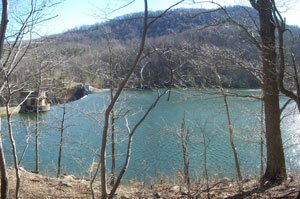NEWS- Case studies: Will new dredge view go entrepreneurial?

51-acre Sugar Hollow reservoir, despite its pristine mountain sources (and pivotal role in 2007 film Evan Almighty), will be abandoned under the controversial 50-year plan. PHOTO BY HAWES SPENCER
A businessman's leap into the fray over the Rivanna Reservoir, three dredging case studies, and new calculations of dredging's effectiveness for watering this community suggest that any new look at the Rivanna Reservoir must move beyond the limitations of a mere engineering study.
"What we need is an on-site assessment of the feasibility and cost of dredging done by a company with experience and a reputation for success in managing complex dredging operations," says Joe Mooney, a citizen who is part of a group urging the Rivanna Water & Sewer Authority to reconsider its 50-year water plan as wasteful of money and resources– as well as potentially dangerous.
The Authority contends that its plan, which involves decommissioning the area's two leading reservoirs for a new cross-county pipeline to fill a planned mega-reservoir, best solves the 50-year water needs of the community– despite its requirement for clear-cutting over 180 acres of Ragged Mountains forest and putting a tip of the reservoir under Interstate 64.
In 2005, the Authority dismissed dredging after its consultants claimed, via a 16-page study, that removing the Reservoir's accumulated sediments would cost up to $145 million. When complaints boiled over last fall at a City Council meeting, the Authority director dropped another bombshell: His consultants were now now claiming that dredging could cost up to $225 million [PDF].
But in last week's Hook cover story, businessman Oliver Kuttner said he would dredge the Reservoir for $195 million less than one estimate and still make "lots of money." If he could pull that off, local water drinkers might have their 50-year thirst quenched for about a tenth of what engineering firm Gannett Fleming estimates.
Already, the Pennsylvania-based firm has drawn fire for receiving over $2.5 million for its local studies, with nearly $3 million more contracted. And the firm appears to be in line for contracts worth another $14 million, according to Authority documents.
All these contracts are just for studies and designs– not for actually constructing anything. And that's part of what's got the critics so riled. They claim the estimated $143 million price tag of the 50-year program will explode once bids come in. (Good news for critics: the latest contract does give the Rivanna Authority a unilateral right to terminate Gannett Feming with just 30 days notice.)
And while several high-profile environmentalists support the pipeline/I-64-area reservoir, the group that has emerged to fight it has green credentials of its own. Citizens for a Sustainable Water Supply says they are troubled by the plan's insistence on clear-cutting 54,000 trees and abandoning the community's existing reservoirs, Sugar Hollow and Rivanna, to death by sedimentation. They note that just as preserving old buildings is considered the most sustainable behavior in the construction industry, ditto for old reservoirs.
As for Oliver Kuttner, he has already recycled the old Woolworth's into downtown's largest mixed-use building, The Terraces, with more than 60,000 square feet of high-end shops and condos. And he turned a corrugated metal beer warehouse into The Glass Building, the site of the trendy X Lounge.
Now, with talk of tens– or hundreds, according to Gannett Fleming– of millions of dollars in dredging, Kuttner wants to buy a dredging machine.
"It would be a dream job," says Kuttner.
"You start throwing numbers like that around, and people get excited," says Steve Miller, the sales manager of Ellicott Dredges, the Baltimore-based company whose diesel-powered "Mud Cat" has become the "it" device of sedimentation salvation for dredging dreamers of the 366-acre Rivanna Reservoir, which has lost about a third of its capacity since it began storing water in 1966.
"Frankly, engineers don't make the best businesspeople," says Miller. "They tend to put things in a worst-case scenario."
Worst-case indeed. While Kuttner has offered to dredge and dispose of five million cubic yards of accumulated sediment from the Rivanna Reservoir for $30 million, the engineering minds at Gannett Fleming claim the job could take $225 million and 50 years of constantly trucking away the spoils.
Such frightening scenarios have steered stunned local officials away from saving their main reservoir, and the Citizens group alleges that Gannett Fleming– ranked #7 in the nation in annual dam design billings by Engineering News-Record– is more attuned to dam-building than dredging. Miller seconds that.
"We're totally involved in this industry," says Miller. "We go to all the shows. That name [Gannett Fleming] never comes up."
In fairness, Miller says he didn't consider all the dredgers the Hook recently quoted as industry leaders either, but he notes that anyone who can operate a GPS and so-called "yellow machinery" can be quickly taught to run a Mud Cat. After all, training is included in the quarter-million-dollar price.
One city that's taken him up on the offer is Decatur, Illinois. A decade-ago contract dredging operation in one part of 2,800-acre Lake Decatur worked so well that the City decided to perform more dredging– this time using its own staff in a multi-year operation. Here's how it works. They identified a big farm and built an earthen dike as the perimeter of a 385-acre area in which millions of cubic yard of sediments will be pumped four miles away for dewatering.
When the operation ends, says Keith Alexander, Decatur's director of water management, the farm will have rich topsoil that climbs 10 to 30 feet above the existing elevation with no cost for trucking. Total cost: between five and seven dollars per cubic yard, which, coincidentally, averages out to what Oliver Kuttner would charge.
On any given day in America, waterways around ports are dredged to facilitate shipping. In Dubai, dredging allows cute islands to emerge in the shape of palms. But finding cities that have dredged for drinking water is harder.
The Hook has found only two large-scale U.S. examples: Decatur, Illinois, and Fairfax, Virginia. Still, that's two more than Gannett Fleming had found in November, 2004, when Albemarle citizen John Martin pushed firm principal Aaron Keno to admit that he hadn't contacted a single American community in formulating his nightmarish scenario of what dredging would mean in Albemarle County. This was 13 days before Keno submitted his report alleging a $145 million pricetag (which later jumped to $225 million). At $45 per cubic foot, Keno's latest estimate nearly quadruples what Fairfax spent ($12.20/cubic yard) and obliterates what Decatur is spending (about $6/cubic yard).
One of the supposed roadblocks to dredging is the hodgepodge of regulatory hurdles that must be jumped, but, as previously reported here, regulators actually favor dredging because it meets the state law that demands the "least environmentally damaging of the practicable alternatives."
Three years ago, the Army Corps of Engineers told local officials, including Rivanna director Tom Frederick and his boss, Rivanna chair Michael Gaffney, that unless pumped-out sediments were to be dumped in a waterway or on top of wetlands that the Corps would have no regulatory oversight.
But what about the DEQ, the state Department of Environmental Quality– was it hard for Fairfax to get a permit?
"They didn't need one," says DEQ spokesperson Bill Hayden.
Again, at that same regulatory round-table in April 2005, the DEQ informed Charlottesville and Albemarle officials that dredging has no lasting impact on water quality and that even the temporary effects from churned-up sediment are minor.
The City Council is supposed to be setting a date for its next meeting on the water supply, but when it does, there could be a call for another study.
"Getting another study is going to take the expenditure of funds," Authority director Frederick said on the Coy Barefoot radio program [see sidebar]. "We haven't gotten direction that there needs to be another study."
When the Hook first began questioning the Gannett Fleming studies, Frederick said that engineering studies are designed to test "assumptions." If there is another study, it'll be interesting to see whether the old assumptions get an overhaul.
SIDEBAR- Pumped up: docs show dredging fulfills 50-year water 'deficit'
The Rivanna Water & Sewer Authority claims that dredging alone can't handle the 50-year water needs of the community, but the Authority's own documents demonstrate otherwise.
Perplexed by persistent allegations of an alleged "deficit" between future water supply and demand, this reporter phoned the Coy Barefoot show on WINA radio Tuesday afternoon, March 11, and confirmed, contrary to assertions on its website, that Rivanna Water & Sewer actually possesses 3.2 million more daily gallons of capacity than it has been saying.
Authority director Tom Frederick, whose February "fact sheets" on dredging [RTF file] and on a new $37 million dam [RTF file] (a dam that can't fill up without a $60 million pipeline) consistently speak of a future water "deficit," appears to have conceded what we spotted is his 2004 "Safe Yield Study": that, despite all the sedimentation that has occurred, the current system has the capacity for 16 million gallons per day, not the 12.8 million gallons per day frequently alleged in Authority documents.
The difference between the Authority's two numbers comes from so-called "stream releases," the practice of setting minimum flows from dams holding back the Moorman's and Rivanna Rivers instead of halting those flows during times of drought.
"In the more than half a dozen times I have listened to Mr. Frederick explain the RWSA water supply proposal," says Betty Mooney, "I have never heard him mention that stream flow requirements have gone from voluntary to mandatory."
Mooney is part of a new citizens group complaining about the Authority's plan to phase out both the Sugar Hollow and the Rivanna Reservoir for the new pipeline and a mega-reservoir along Interstate 64.
As evidence of a "deficit," the Authority has been claiming that its current capacity of only 12.8 million gallons per day will be quickly outstripped by demand. In fact, as Frederick conceded Tuesday on Barefoot's program, current voluntary stream releases only become mandatory under the state permit filed in anticipation of the new dam.
"The permit that we just recently approved made them mandatory," Frederick admitted on the radio program. In a post-interview email, Frederick contends that he has "consistently communicated" this point.
In a cover story published last week, the Hook cited the Authority's own consultant to find that dredging the Rivanna Reservoir would supply the system with 5.5 million gallons of daily capacity. Combine that with existing capacity of 16 million gallons per day, and that equals capacity of 21.5 million gallons per day, which is 115% of the projected need in 50 years of 18.7 million gallons per day.
(Last year, demand averaged just 9.7 million gallons per day, and, according to the Authority website [PDF], recent demand has been just 8.2 million gallons per day.)
On the same March 11 radio program, former City Councilor Kevin Lynch called in to remind Frederick that last November, four out of five City Councilors asked for a second opinion on dredging. Frederick told the radio audience that he'll wait until his board demands a second opinion.
Meanwhile, his office recently released a new nightmare. With interest and principal payments already consuming 46 percent of his annual budget [PDF], Frederick wants to more than double the Authority's debt by borrowing another $105 million.

#